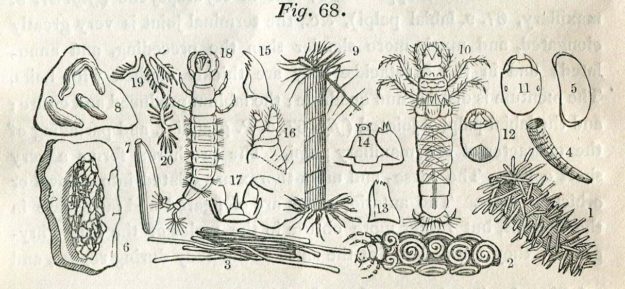J. O. Westwood, An Introduction to the Modern Classification of Insects, vol. II, Londres, Longman, Orme, Brown, Green & Longmans, 1840, p. 63-64.
The larvae ordinarily reside in cylindrical cases, open at ezch end, to which they attach various matters, as bits of sticks, weeds, pebbles, or even small living shells (fig. 68. 2. cases of P. fucsa Pictet), by the assistance of silken threads, which they spin from the mouth in the same manner as caterpillars. Some cases are formed of fine sand, and curved (fig. 64.4. case of Sericostoma multiguttatum Pictet). The larva remains in this case, exposing only its head and three anterior segments of the body, and which it suddenly withdraws on the slightest alarm.

The cases formed by these larvae being ordinarly composed of materials scarecely specifically heavier than the water, are easily carried about. There does not appear to be an exclusive regularity in the choice of the materials of which they are formed, according to the différence of species, the individuals of each employing occasionally, what comes nearest to them when engaged in its construction. M. Pictet indeed appears to consider that each species chooses its own peculiar materials for the construction of its case, and that the mode in which these articles are applied is uniform. Thus, P. rhombica selects morsels of straws or twigs, which it arranges transversely ( fig. 68. 1.) ; whilst P. lunaris employs the same materials, which it attaches longitudinally (fig. 68.3.). He, however, mentions a variety of instances in which materials of a perfectly different kind had been employed by these species. In some species, the materials ( ordinarily strips of leaves) are arranged in a spiral coil ( fig. 68.9. pupa case of P. varia Pict . Reaum. 3. pl. 14. f.9).
When the case, owing to the growth of the inhabitant, becomes too small, it has been stated by some authors that, the larva quits it and constructs a new one ; but M. Pictet considers that it rather adds fresh materials of an enlarged diameter at the aperture, cutting off a portion of the opposite end, whichwould account for the conical form which these cases often exhibit.
In the preface to the Historia Insectorum of Ray, p.XII., is published an interesting tabular arrangement of these cases, « ex observatione D. Willughby », of which an extract will be sufficient to prove the assiduous but neglected researches of our celebrated countryman.
« Insecta aquatica thecis se contegentia sunt, vel theca
immobili, seu lapidibus affixa, corpore vel
subrotundato cum filamentis ad latera
plano et compressiore absque filamentis
mobili aut portatili, migratoria ; Phryganea vulgo dicta. (Then follows an admirable descriptions of the larvae inhabiting these moveable cases)
Suntque vel thecis
rectis, vel habentibus
festucas agglutinatas
parallelas (straw-worms)
transversas et breviores, quibus interdum admiscentur lapilli
et concule ;
festucas nullas adhaerentes, sed lapillos aut arenulos quae vel
teretes, (cod-baits)
planae, seu compressae,
lapillis majusculis, thecae lateribus adhaerentibus nunquam
supinae aut pronae parti ;
nullis ad latera adhaer. Apillis, sed theca utrinque in
tenuem marginem, seu limbum procurrente velu talas
quasdam, theca planiore et compressiore quam in superiore.
Incurvis seu cornutismavis dicere. Sunt enim horum thecae
Incurvae, et ina extremitate majore, altera minore. »
The Rev. J. Morton, also in his History of Northamptonshire, chap. vii. Has entered into many particulars relative to these larvae and their cases, as has also Sir Humphrey Davy, in his Salmonia. See also Insect Architecture, chap. x. Isaac Walton has also given many particulars of these insects, especially as regards their piscatorial qualities, and which he calls cadis, pipers, cockspurs, straw-worms, or ruff-coats. In Mr Ronalds’s Flyfisher’s Entomoloy various moderate sized species of Phryganae are termed sans-flies, grannums, and cinnamon-flies ; whilst one of the Mystacidae is naemed the silver horns.
The larva of these insects (fig. 68. 10. larva of Phryganea rhombica Pictet) are of an elongated, nearly cylindrical form, with a scaly head (fig. 68 11. upper, 68. 12. under side of head or larva of P. striata Pictet), furnished with a bilobed upper lip, a pair of strong mandibles, obtuse at the tip, with several short teeth ( fig. 68. 13 mand. of larvae of Hydropsyche they are terminated by a more elongated tooth ( fig.68 15. mand. of larva of H. senex Pictet) ; and these species are more essentially carnivorous than the others. The maxillae and labrum are small, fleshy, and soldered together (fig. 68. 14. P. striata Pictet) ; the former are terminated by two minute corneous point, supposed by Pictet to represent the terminal maxillary lobe and palpus, of which there is no other rudiment ; neither does there appear to be any labial, except two exceedingly minute points on each side of the spinneret, which is also very minute.